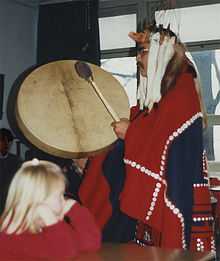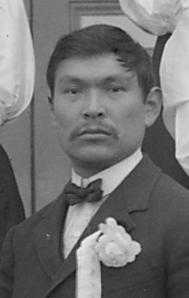Tsimshian people

The Tsimshian (/ˈsɪmʃiən/; Sm'algyax: Ts’msyan) are an indigenous people of the Pacific Northwest Coast. Tsimshian translates to Inside the Skeena River.[1] Their communities are in British Columbia and Alaska, around Terrace and Prince Rupert and the southernmost corner of Alaska on Annette Island. There are approximately 10,000 Tsimshian. Their culture is matrilineal with a societal structure based on a clan system, properly referred to as a moiety. Early anthropologists and linguistics grouped Gitxsan and Nisga'a as Tsimshian because of linguistic affinities. Under this terminology they were referred to as Coast Tsimshian, even though some communities were not coastal. The three groups identify as separate nations. There are many other ways to spell the name, such as Tsimpshean, Tsimshean, Tsimpshian, and others, but this article will use the spelling "Tsimshian".
History

At one time the Tsimshian lived on the upper reaches of the Skeena River near present-day Hazelton BC. After a series of disasters befell the people, a prince led a migration away from the cursed land to the coast, where they founded Kitkatla, reputed to be one the oldest continually inhabited communities on Earth.[citation needed] Following suit, other Tsimshian chiefs later migrated down the river and began to occupy all the lands of the lower Skeena valley. Over time these groups developed a new dialect of their ancestral language and came to regard themselves as a distinct population, the Tsimshian proper, while still sharing all the rights and customs of the Gitksan, their kin on the upper Skeena.
In 1862 a smallpox epidemic annihilated many Tsimshian people. Further epidemics ravaged their communities until the late 1890s. Altogether, one in four Tsimshian died in a series of at least three large-scale outbreaks, . Lax Kw'alaams began burying their dead without ceremony on Rose Island. From this time forward many Tsimshian adopted the language, religion, and culture of nearby White colonists, who were predominantly Protestant and English. The Head Chiefs themselves were the ones who led the process of assimilation. Only in the 1970s did Tsimshian communities begin to return to their traditional culture, which appeared first in the school district.
In the 1880s the Anglican missionary William Duncan, with a group of Tsimshian, requested settlement on Annette Island from the U.S. government. After approval, the group founded New Metlakatla in Alaska. Duncan later requested that the community gain reservation status, and eventually, with the passage of the Alaska Native Claims Settlement Act, it became the only Native reservation in the state. [citation needed]
The New Metlakatla Tsimshian maintained their reservation status and holdings exclusive of the Alaska Native Claims Settlement Act. They do not have an associated Native Corporation, although Tsimshian in Alaska may be shareholders of the Sealaska Corporation.
The Annette Island reservation was the only location in Alaska allowed to maintain fish traps, which were otherwise banned when Alaska became a state in 1959. The traps are used to provide food for people living on the reservation. Legally the community was required to use the traps at least once every three years or lose the right permanently. This practice was stopped early in the 2000s and they are no longer allowed.
In British Columbia, the governments of Canada engaged in the British Columbia Treaty Process with First Nation bands in the province. The Tsimshian First Nations pursued negotiations until late 2005 when the Tsimshian Tribal Council, the organization representing each of the First Nations in treaty negotiations, dissolved amid legal and political turmoil.
Culture
.jpg)
Like all Northwest Coastal peoples, they thrived on the abundant sea life, especially salmon. The Tsimshian were a seafaring people, like the Haida. A staple for many years, the salmon continues to be at the center of their nutrition, despite large-scale commercial fishing. This abundant food source enabled the Tsimshian to live in permanent towns.
They lived in large longhouses, made from cedar house posts and panels. These were very large, and usually housed an entire extended family. Cultural taboos related to prohibiting women and men eating improper foods during and after childbirth. The marriage ceremony was an extremely formal affair, involving several prolonged and sequential ceremonies.
Tsimshian religion centered around the "Lord of Heaven", who aided people in times of need by sending supernatural servants to earth to aid them. The Tsimshian believed that charity and purification of the body (either by cleanliness or fasting) was the route to the afterlife.
As with all Northwest Coastal peoples, the Tsimshian engage in the potlatch, which they refer to as the yaawk, or feast. Today in Tsimshian culture, the potlatch is held at gatherings to honor deaths, burials, and succession to name-titles.
The Tsimshian live on in their art, their culture and their language, which is making a comeback. Like other coastal peoples, the Tsimshian fashioned most of their goods out of Western red cedar, particularly from its bark. It could be fashioned into tools, clothing, roofing, armor, building materials and canoe skins. They used cedar in their Chilkat weaving, which they are credited with inventing.[2] The Tsimshian competed with the Tlingit, Haida, the Athapaskan groups in the north and east, and the Wakashan groups in the south.
Tribes
The Tsimshian nation (meaning the Coast Tsimshian) in British Columbia consists of fourteen tribes:
- the Gitdidzu or Kitasoo (who live at Klemtu, B.C.)
- the Gitga'at (Hartley Bay, B.C.)
- the Gitxaala or Kitkatla (Kitkatla, B.C.)
- the Gitsumkalum (Kitsumkalum, B.C.)
- the Gits'ilaasü or Kitselas (Kitselas, B.C.)
- The allied tribes of Lax Kw'alaams (Port Simpson) including Metlakatla
Clans
The Tsimshian clans are the
- Laxsgiik (Eagle Clan),
- Gispwudwada (Killer Whale Clan)
- Ganhada (Raven Clan)
- Laxgibuu (Wolf Clan)
Treaty process
The Tsimshian wanted to preserve their villages and fishing sites on the Skeena and Nass Rivers as early as 1879. They were not able to begin negotiating a treaty with the Canadian government until July 1983.[3] A decade later, fourteen bands united to negotiate under the collective name of the Tsimshian Tribal Council. A framework agreement was signed in 1997, and the Tsimshian nation continues to negotiate with the BC Treaty Commission to reach an Agreement-in-Principle.[4]
Language
The Tsimshian speak a Tsimshianic language, referred to by linguists as "Coast Tsimshian" and by Tsimshians as Sm'algyax, which means "real or true tongue." It has differing dialects from the North in Taquan to the south in Klemtu. Tsimshian also speak the same language as the Gitxsan and the Nisga’a, yet the dialect is further differentiated than the regional Tsimshian variations. Very few speakers remain today in Canada and Alaska. Some linguists classify Tsimshianic languages as a member of the theoretical Penutian language group.
Notable Tsimshian people

- Jeff Morris, Speaker Pro Tem and Representative Washington State House of Representatives
- Frederick Alexcee, artist
- William Beynon, Gitlaan and ethnographer
- Heber Clifton, hereditary chief of the Gitga'ata and community leader
- Marcia Crosby, art historian
- Alfred Dudoward, hereditary chief of the Gitando, and leader of the Port Simpson Methodist Movement. co-founder of the Native Brotherhood
- Benjamin Haldane, pioneering photographer from Metlakatla village
- Bill Helin, artist
- Calvin Helin, Ginaxangiik, lawyer, businessman and author
- William Jeffrey, Gitwilgyoats, hereditary chief, activist, carver
- Paul Legaic, hereditary chief of the Gispaxlo'ots and trader. The first Police Chief of New Metlakatla.
- Rev. Edward Marsden, clergyman
- Charles Menzies (anthropologist)
- Odille Morison, translator and art collector
- Rev. William Henry Pierce, missionary and memoirist
- Peter Simpson, Native Americans rights activist
- Henry W. Tate, Gispakloats, oral historian, tribal headman
- Roy Henry Vickers, artist
- Arthur Wellington Clah, from the house of Tamks of the Gispaxlo'ots. Translator at Fort Simpson, the first to teach Father Duncan the Sm`algyax language, diarist
- Walter Wright, hereditary chief of the Gits'ilaasü (Kitselas) and oral historian
- Shannon Thunderbird, Singer, Songwriter, Speaker, Author/Arts Educator, Recording artist
- David Albert Boxley Sr. Northwest Coast Artist, Tsimshian Totem Pole and Mask Carver, Git-Hoan Tsimshian Dance Leader, Tsimshian Arts and Language Teacher
- Billy Thunderkloud, Entertainer, Recording Artist
Anthropologists and other scholars who have worked with the Tsimshian
- Margaret (Sequin) Anderson
- Marius Barbeau
- William Beynon
- Franz Boas
- Caroline F. Butler
- Philip Drucker
- Wilson Duff
- Viola Garfield
- René Girard
- Marjorie Halpin
- Susan Marsden
- Charles Menzies
- James McDonald
- Jay Miller
- Chris Roth
Missionaries who worked among the Tsimshian
- William Henry Collison
- Thomas Crosby, Methodist
- William Duncan, Anglican/independent
- Edward Marsden, Presbyterian
- Bishop William Ridley, Anglican
- Robert Tomlinson, Anglican
- Joseph Burton
- David H. Pieplow
See also
- Tsimshian mythology
- Gitksan language
- Nisga'a language
- Coast Tsimshian
Notes
- ↑ Campbell, Lyle (1997). American Indian Languages: The Historical Linguistics of Native America. Oxford: Oxford University Press, pg. 396 n. 29
- ↑ Shearer, Cheryl. Understanding Northwest Coast Art. Vancouver: Douglas & McIntyre, 2000: 28 ISBN 0-295-97973-9.
- ↑ Kitsumkalum and the Tsimshian Treaty Process Kitsumkalum Treaty Office
- ↑ Tsimshian First Nations - BC Treaty Commission
References
- Barbeau, Marius (1950) Totem Poles. 2 vols. (Anthropology Series 30, National Museum of Canada Bulletin 119.) Ottawa: National Museum of Canada.
- Boas, Franz, "Tsimshian Mythology", in Thirty-First Annual Report of the Bureau of American Ethnology to the Secretary of the Smithsonian Institution, 1909–1910, pp. 29–1037. Washington: Government Printing Office, 1916.
- Garfield, Viola, "Tsimshian Clan and Society", University of Washington Publications in Anthropology, vol. 7, no. 3 (1939), pp. 167–340.
- Garfield, Viola E., and Paul S. Wingert, The Tsimshian Indians and Their Arts, Seattle: Washington, University of Washington Press, 1951, 1966.
- Halpin, Marjorie M., and Margaret Seguin, "Tsimshian Peoples: Southern Tsimshian, Coast Tsimshian, Nishga, and Gitksan", In: Handbook of North American Indians, Volume 7: Northwest Coast, edited by Wayne Suttles. Washington, DC: Smithsonian Institution, 1990, pp. 267–284.
- McDonald, James A. (2003) People of the Robin: The Tsimshian of Kitsumkalum, CCI Press.
- Miller, Jay, Tsimshian Culture: A Light through the Ages, Lincoln, NE: University of Nebraska Press, 1997.
- Miller, Jay, and Carol Eastman, eds., The Tsimshian and Their Neighbors of the North Pacific Coast, Seattle, WA: University of Washington Press, 1984.
- Neylan, Susan, The Heavens Are Changing: Nineteenth-Century Protestant Missions and Tsimshian Christianity, Montreal: McGill-Queen’s University Press, 2003.
- Seguin, Margaret, Interpretive Contexts for Traditional and Current Coast Tsimshian Feasts. Ottawa, ON: National Museums of Canada, 1985.
- Seguin, Marget, ed., The Tsimshian: Images of the Past, Views for the Present. Vancouver, BC: UBC Press, 1984.
External links
| Wikimedia Commons has media related to Tsimshian. |
- The Canadian Museum of Civilization - Tsimshian Prehistory
- Map of Northwest Coast First Nations (including Tsimshian)
- Tsimshian Text List of Tsimshian Text by Boaz, F.